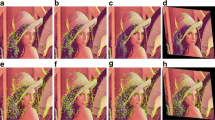Abstract
Object removal is a malicious image forgery technique, which is usually achieved by exemplar-based image inpainting in a visually plausible way. Most existing forgery detection approaches utilize similar block pairs between inpainted area and the rest areas, but they invalidate when those inpainted images are further subjected to some post-processing operations such as JPEG compression, Gaussian noise addition and blurring. It is desirable to develop a forensic method which is robust to object removal with post-processing. From some preliminary experiments, we observe that post-processing destroys the similarity of block pairs and simultaneously disturbs the correlations among adjacent pixels to some extent. Inspired by the strong ability of joint probability density matrix (JPDM) in characterizing such correlation, we propose a hybrid forensics strategy. Firstly, our earlier method is employed to detect whether a candidate image is forged or not. Secondly, for those undetected images after the first step, JPDM is computed for each difference array to model the correlations among adjacent DCT coefficients, and the average of these matrixes are computed as feature vectors to further expose tampering traces. Experimental results show that the proposed approach can effectively detect object removal by exemplar-based inpainting either with or without post-processing.








Similar content being viewed by others
Notes
Available at http://dde.binghamton.edu/download/ensemble/.
Available at http://yokoya.naist.jp/research2/inpainting/.
References
Amerini I, Ballan L, Caldelli R et al (2013) Copy-move forgery detection and localization by means of robust clustering with J-linkage. Signal Process Image Commun 28(6):659–669
Bacchuwar KS, Ramakrishnan K R (2013) A jump patch-block match algorithm for multiple forgery detection. In: Proc. of IEEE international multi-conference on automation, computing, communication, control and compressed sensing (iMac4s), pp 723–728
Birajdar G K, Mankar V H (2013) Digital image forgery detection using passive techniques: A survey. Digit Investig 10(3):226–245
Chang I, Yu J, Chang C C (2013) A forgery detection algorithm for exemplar-based inpainting images using multi-region relation. Image Vis Comput 31 (1):57–71
Cozzolino D, Gragnaniello D, Verdoliva L (2014) Image forgery detection through residual-based local descriptors and block-matching. In: IEEE International conference on image processing (ICIP), pp 5297–5301
Criminisi A, Prez P, Toyama K (2004) Region filling and object removal by exemplar-based image inpainting. IEEE Trans Image Process 13(9):1200–1212
Gu B, Sheng V S, Wang Z et al (2015) Incremental learning for v-support vector regression. Neural Netw 67:140–150
Gu B, Sheng V S, Tay K Y et al (2015) Incremental support vector learning for ordinal regression. IEEE Trans Neural Netw Learn Syst 26(7):1403–1416
Guillemot C, Meur O L (2014) Image inpainting: overview and recent advances. IEEE Signal Process Mag 31(1):127–144
He Z, Lu W, Sun W et al (2012) Digital image splicing detection based on Markov features in DCT and DWT domain. Pattern Recog 45(12):4292–4299
Kakar P, Sudha N (2012) Exposing postprocessed copy-paste forgeries through transform-invariant features. IEEE Trans Inf Forens Secur 7(3):1018–1028
Kirchner M, Fridrich J (2010) On detection of median filtering in digital images. SPIE Electron Imag Int Soc Opt Photon 754110–754110
Kodovsky J, Fridric J, Holub V (2012) Ensemble classifiers for steganalysis of digital media. IEEE Trans Inf Forens Secur 7(2):432C444
Li J, Li X L, Yang B, Sun X M (2015) Segmentation-based image copy-move forgery detection scheme. IEEE Trans Inf Forens Secur 10(3):507–518
Liang Z, Yang G, Ding X et al (2015) An efficient forgery detection algorithm for object removal by exemplar-based image inpainting. J Vis Commun Image Represent 30:75–85
Liu Q, Chen Z (2014) Improved approaches with calibrated neighboring joint density to steganalysis and seam-carved forgery detection in JPEG images. ACM Trans Intell Syst Technol 5(4):63
Muhammad G, Hussain M, Bebis G (2012) Passive copy move image forgery detection using undecimated dyadic wavelet transform. Digit Investig 9(1):49–57
Stamm M C, Wu M, Liu K J R (2013) Information forensics: an overview of the first decade. IEEE Access 1:167–200
Shi Y Q, Chen C, Xuan G et al (2007) Steganalysis versus splicing detection. Int Workshop Digit Watermark 158–172
Wang J, Lu K, Pan D et al (2014) Robust object removal with an exemplar-based image inpainting approach. Neurocomputing 123:150–155
Wu Q, Sun S J, Zhu W et al (2008) Detection of digital doctoring in exemplar-based inpainted images. In: Proc. of IEEE international conference on machine learning and cybernetics, vol 3, pp 1222–1226
Xia Z H, Wang X H, Sun X M, Wang B W (2014) Steganalysis of least significant bit matching using multi-order differences. Secur Commun Netw 7 (8):1283–1291
Xia Z, Wang X, Sun X et al (2016) Steganalysis of LSB matching using differences between nonadjacent pixels. Multimed Tools Appl 75(4):1947–1962
Xia Z, Wang X, Zhang L et al (2016) A privacy-preserving and copy-deterrence content-based image retrieval scheme in cloud computing. IEEE Trans Inf Forens Secur 11(11):2594–2608
Zhao X, Wang S, Li S et al (2013) Image splicing detection based on noncausal markov model. In: IEEE International conference on image processing, pp 4462–4466
Acknowledgements
We would like to thank the anonymous reviewers for their professional comments and valuable suggestions. This work is partially or fully sponsored by National Natural Science Foundation of China (61572183, 61379143), the Specialized Research Fund for the Doctoral Program of Higher Education (20120161110014), the Scientific Research Fund of Hunan Provincial Education Department of China (14C0029), Natural Science Foundation of Hunan Province (2016JJ2005). The authors appreciate the nice help from Mr Moses Odero for his improving the English usages.
Author information
Authors and Affiliations
Corresponding author
Rights and permissions
About this article
Cite this article
Zhang, D., Liang, Z., Yang, G. et al. A robust forgery detection algorithm for object removal by exemplar-based image inpainting. Multimed Tools Appl 77, 11823–11842 (2018). https://doi.org/10.1007/s11042-017-4829-0
Received:
Revised:
Accepted:
Published:
Issue Date:
DOI: https://doi.org/10.1007/s11042-017-4829-0




